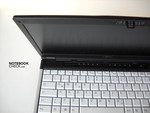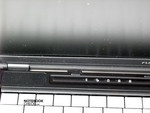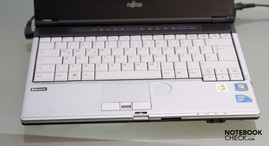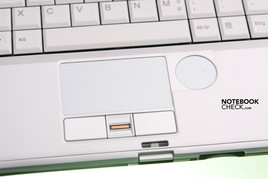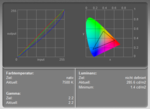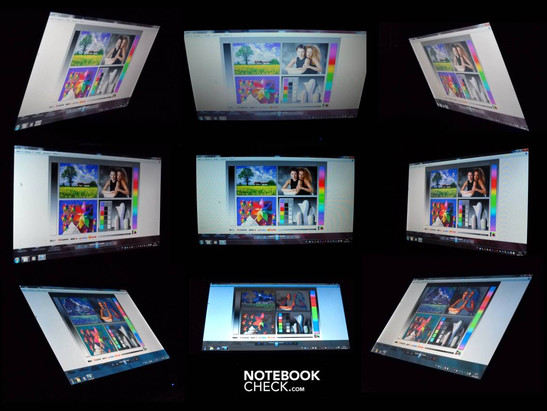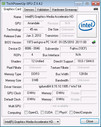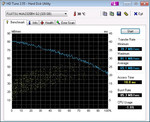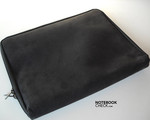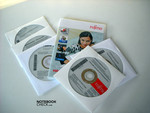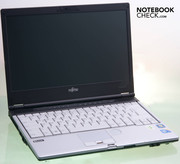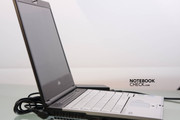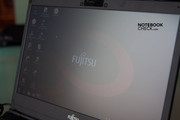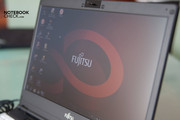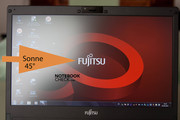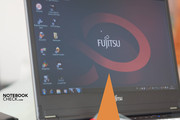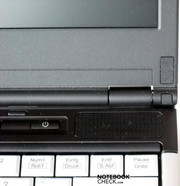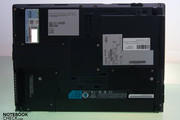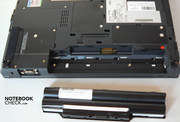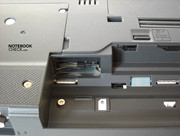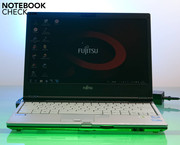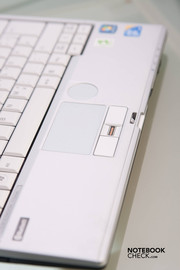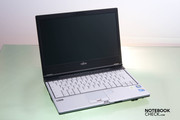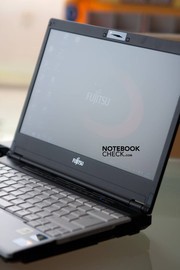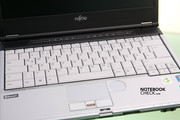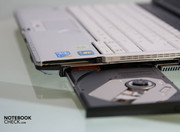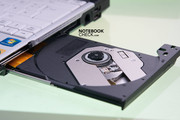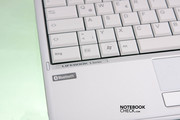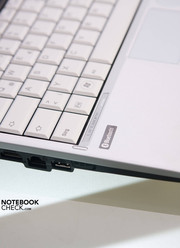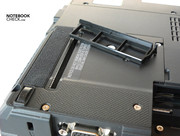Review Fujitsu Lifebook S760 Notebook
Meanwhile, the brand "Fujitsu" has come to be the world's number three, behind HP and Dell. About a year after leaving the joint venture with Siemens, we want to see how the products of Fujitsu Technology Solutions Ltd (FTS) have developed. The product strategy of FTS also ranges into the field of Consumer Electronics, however the majority of products are found in the business field. The "Lifebook S760 UMTS Highline" equally so. Fujitsu dares a balancing act between mobility and connectivity on the one side and performance on the other with this 13.3 inch notebook. Aside from Intel's current hardware platform with the newest Core i7-620M processor (2.66 GHZ, 4 MB cache) and a QM57 chip set with iAMT (Intel Active Management Technology, part of the vPro platform), there is also a UMTS module in the device. The Lifebook with a matt LED display and integrated graphic chip (Intel Graphics Media Accelerator HD) proves to be energy saving - thus a relatively long battery life at low weight is possible even with a small 6 cell battery. The hard disk appears to be sufficiently sized with 320 GB - not exactly opulent, but sufficient.
The integration of Intel's vPro platform with special maintenance and assessment features demonstrates that the Lifebook S-Series hasn't only been conceived for the individual business person, but also waits for employment in larger corporation infrastructures. Different than the consumer range, which allegedly distinguishes itself majorly by various multimedia traits, these characteristics can be waived on in the business field. Keywords, like platform stability (hardware and software, e.g. spare parts, drivers), remote maintenance options and connectivity characterize the claim here. The Intel chip set, QM57, responsible for the Core i7-620M processor supports various functions for computers' inventory and remote diagnosis and repair (even when the system is deactivated, has an operating system crash or defect hardware components). You can find a whitepaper for vPro here.
Case
Dimensions: 314 mm wide, 222 mm deep, 31 mm high. Weight: 1.9 kg with standard battery Material: Plastic Display lid with magnesium coating. Colors: Black and mousy. In short: An inconspicuous, light business notebook.
Mobile business companions should prove to have a certain case stability in order not to give up its ghost in tight briefcases, between hectic setting ups and taking downs or during jolty train journeys. The Fujitsu Lifebook unfortunately economizes here. The case doesn't seem clattery but it's not exactly suitable for a business day on the move either. The plastic applied to the case is just strong enough to have a reasonable torsional stiffness. Unfortunately, the case's mixed impression is continued on the notebook's potential weak points: the keyboard's center, in the function keys on the upper edge, over the drive slot and in the display lid. Here the case can be partly bent and depressed more than it's usual by applying moderate pressure with a finger.
It looks even worse for the display. The lower bezel is slightly detached from the display; the lid is hardly rigid and can be dent massively in the center. The display hinges look stable at first sight, but can't prevent the display from teetering intensely under slight vibrations. Furthermore, the display's closure proves to be minimalistic: there is merely one locking mechanism in the center. It is tight, but due to the case lid lacking stability, the display's corners can easily be bent far outwards. On the one hand, this involves the risk of the display fracturing, and on the other it's possible for objects to penetrate accidentally - e.g. a pen in the briefcase, which could scratch the display. A double lock and a slight beveling of the case's edge would have been more sensible. This clamshell design might seem a bit old-fashioned for a few users, but it has proven to be a hitherto unprecedented protection function for the display. Besides that it also contributes to the notebook lid's torsional stiffness.
A further, even if not quite as grave, critique point of the case could be the many small air vents. These are found on the bottom and on the lateral edges. Fortunately however, there is a maintenance cover on the CPU air vent, which can be opened and cleaned.
The applied, unlit status indicators used in prior versions from Fujitsu-Siemens have been replaced by the usual (multi-colored) LEDs. Surprisingly, comfort or information losses don't result from that.
The wrist-rest below the keyboard is structured with small squares and thus improves the supportive feel during longer work periods. The magnesium coated display lid looks similar to Lenovo's Thinkpads, but is much more sensitive. Greasy fingers and scratches quickly find their way on the notebook and are only difficult to banish again. But it is definitely better than the currently circulating high-gloss design - whereby this is also a matter of taste.
Connectivity
Two internal microphones, stereo loudspeakers and a 1.3 Mpixel named "conference cam" are to provide for collaboration possibilities, aside from UMTS and WLAN.
A further flexibility boost is supplied by the modular exchange slot, in which a DVD drive (AD-7930H) from Sony's subsidiary, Optiarc, has been built into our prototype. Alternately, it can also be equipped with a supplementary battery or a second hard disk.
Aside from a TPM module V1.2, a fingerprint reader, a shock sensor for protecting the hard disk against jolts and, according to the data sheet, "Intel Anti Theft Technology" as part of vPro take care of security issues.
Interfaces
The interfaces have all been placed prudently and easily accessible on the case. The audio sockets and SD cardreader are on the front, the VGA port on the back. The other cabled ports are distributed on the right (V.92 modem, 2 USBs, ExpressCard) and left (DC-in, HDMI, LAN, 1 USB with Anytime Charge function, WLAN switch). The webcam has been integrated seamlessly on the upper display bezel. Logically, the interface for the docking station is on the bottom. The UMTS card slot can first be accessed when the battery is removed.
Software
The business alignment is immediately apparent in the software configuration, as well. Fujitsu supplies a extensive tool package beside Windows 7 Professional 64 bit. It includes a driver management with update function, a display manager (e.g. for presentations, etc.), a management program for network profiles and a program for energy savings options. Fujitsu provides Corel Home Office, CorelDRAW Essentials 4, a PDF creator from Scansoft and Serif PhotoPlus X2 for office use.
There is also a recovery DVD for Windows 7 and even a Windows XP Professional DVD (but 32bit) included in the scope of delivery.
However, a few of these tools seem to be redundant because they don't bid any more functions than Windows 7. Thus, "Power Saving Utility" merely creates its own profile in Windows energy settings. WLAN profiles can also be configured with Windows. In return, the driver management tool, with which all components in the notebook can easily be updated, is practical. The display manager, where various settings for projectors and different resolutions can be stored and quickly accessed, is just as handy. This eliminates extensive adjustments prior to a presentation.
Supplies
Apart from the adapter, there is also an leather imitate protection bag in the box. The material is, however, quite sensitive for any kind of grime and only difficult to clean - especially dust.
It's possible to additionally acquire a lot of supplies, as hardware, software and service: A second battery or hard disk in the exchange slot, power adapter, docking station/port replicator, extended warranty service with a response period of a day and various security and management services (ComputraceOne, Advanced Theft Protection, Theft recovery, Asset Tracking, etc.). These allow e.g. a targeted deactivation of stolen devices, destroying data or localizing stolen notebooks. These versatile functions are made available by the vPro platform and supplementary software - they're not to be found in consumer devices. In-depth information about Advanced Theft Protection with a nice ad-video can be found at the end of this article.
Input Devices
Keyboard
The Lifebook S760's keyboard is, contrarily to the latest trend, not dark with white letters, but the exact opposite. Dark letters on a white surface allow for a relaxed working. Touch-typists won't care much about the keyboard's color. This color combination is more suitable than the dark versions for two finger typists and occasional look-seers, though. This is because dark letters have more contrast and are delimited better, whereas white letters "fray out" on the edges and have less distinct contours. The bright keys can be recognized better even in the dim light of trains or poorly illuminated offices.
The keyboard's keys are big and have almost the same layout as a normal keyboard. Special keys, like "Pos1" and "End" have been placed in the F-row and the ""Page" keys next to the arrow keys. The single keys have a large stroke and a solid pressure point. The keyboard makes a slightly clattery and vague impression when the fingers only lie on the keys, though. The keyboard material has a pleasant feel. You shouldn't hit the splash water protected keyboard to hard anyway, because the chassis quickly bends.
Touchpad
The touchpad's surface is slightly roughened and therefore haptically good to use. Both the pad as well as the two keys are big enough to use even longer as a mouse substitute. Fujitsu has placed the fingerprint reader space-saving between the pad keys. It doesn't get in the way there either, as for instance on the wrist-rest in other devices. The S760 takes an unusual, and certainly in need of accustoming, way for the mouse middle key's replacement: It has been designed as a small, round pad on the actual touchpad's right and takes over a scroll or rotate function (configurable). However, the thumb tends to hit this field while typing and thus it can quickly lead to cursor-leaps during work. In return, the mouse replacement keys are pleasant to click. Another special feature is a function called "Momentum", which imitates the physics of a trackball's motion. Apart from that, finger gestures are supported, even if quite limited.
The touchpad's configuration and its functions are made in the mouse dialog. The comprehensive explanation is pleasant, as it helps you decide which function you want or don't want to use. There is even a video explanation for finger gestures.
Display
The display presents itself as exceptionally thin and bright, but only moderately stable due to Eged LED Technology. As usual, and necessary for a business notebook, the Fujitsu Lifebook does without an annoyingly reflective display. The 16:9 aspect ratio is rather impractical for an office notebook. The resolution is typical for the display size, with 1366x768 pixels. The required, homogeneous (88%) high (268 cd/m2 on average) illumination for office mode isn't a problem for the screen. The brightness decreases upwards, but this happens evenly. Shadows or light spots can't be seen. However, the LEDs' irradiation can be seen on the lower edge when the screen is dark.
| |||||||||||||||||||||||||
Brightness Distribution: 88 %
Center on Battery: 289 cd/m²
Contrast: 161:1 (Black: 1.8 cd/m²)
The viewing angle dependency isn't overwhelming but o.k. for the notebook class. The colors falsify quickly and the brightness decreases especially from the sides. Due to the matt surface and high luminosity, the device can be used outdoors without hesitation. Not as good, but also not as important for this notebook class, is the rather high black value of 1.8 and the low contrast. Reflective gaming notebooks have significantly better rates here. Good news is that the display can also be used with its full brightness in battery mode.
Performance
Intel's Core i7-620M doesn't just differ from its Core Duo range predecessor in terms of processor architecture, but it's also accompanied by a new feature for Intel processors and a new feature in general. The front side bus (FSB), which linked the processor to the RAM, has proved to be a bottleneck in the past. Like AMD has already done in 2003, Intel has now integrated the memory controller directly in the CPU. Absolutely new in the world of x86 is the implementation of a graphic chip on the processor base. Thus, the main board chip set doesn't have much to do anymore - other than to provide interfaces and vPro functions.
The Core i7-620M is a real mobile dual-core version from the Core i7 range and is already manufactured in the newest 32 nm structure process to a part. The GMA HD graphic chip is still a bit coarser with 45 nm. The 620M's performance level is above the older Core 2 Duo's leaders. The power consumption is in the middle at 35 watts and therefore again on par with comparable Core 2 Duo (T) models. However, this rate already included the memory controller's and graphic chip's power consumption. The Core range introduces two more or less new features. For one thing, hyperthreading known from P4 times and for another the long forgotten turbo mode from 286 days - okay, the clock rates are something else (up to 3.33 GHz). How much impact and how high the turbo's overclocking will really be is dependent on the load of the other CPU and GPU cores and the given cooling.
| PCMark 05 Standard | 6832 points | |
| PCMark Vantage Result | 6178 points | |
Help | ||
The processor performance is more than sufficient for the mobile business person, as the 620M is one of the currently strongest two core chips. Together with the lush RAM configuration, it also guarantees smooth working with modern (bloated) (Java) applications. Even the XP mode or small virtual machines aren't a big challenge for the light notebook. The RAM configuration may even suffice for small developer tasks with a common IDE. A smooth rendering of high resolution media content is possible because the graphic card supports the processor at HD decoding - but not from BluRay, as it doesn't have the necessary drive - it wouldn't fit to the application scenario that Fujitsu has thought for this device, either.
The Intel Graphics Media Accelerator HD Graphics doesn't have much to offer in terms of gaming performance, as expected. Undemanding or older games (WoW, Quake 3) run at most. However, it proves to be very energy saving due to dynamic clocking and the overclocking function. A more precise overview of the graphic chip's gaming performance can be found here.
| 3DMark 03 Standard | 5007 points | |
| 3DMark 05 Standard | 3367 points | |
| 3DMark 06 Standard Score | 1891 points | |
Help | ||
The built-in 2.5 inch SATA hard disk's rates are in the usual range. It supplies a maximum transfer rate of 81 MB/s with a notebook hard disk typical 5400 revolutions per minute and thus, there's no reason for complaint. The hard disk's temperature is between 28°C (idle) and 32°C (load). Nevertheless, the hard disk often proves to be the bottleneck in data handling and the slow data delivery leads to delays. A solid state disk would have been a very good alternative here.
An interesting technology, which contributes to data security and computer longevity, is the hard disk's shock sensor. It recognizes if the notebook is being moved and sets the hard disk's write and read heads in their rest state so that they don't contact the hard disk surface during jolts and thus, can't damage data. The senor's sensitivity can be controlled via software (e.g. practical during train journeys, when slight vibrations last a longer time). We haven't tested to which extent the notebook will be suitable as a Wii portable replacement.
Emissions
System Noise
The fan runs perpetually. It's always present even in idle mode with 31 dB(A), although the consistent noise can easily be pushed into the background or is drowned out by colleagues in office routine. Up to 43 dB(A) is possible under load - and then there is a lot of noise in the case. A high pitched peep belongs to the party, and every now and again a weird vibration or staggering joins into the soundscape. This is everything but pleasant for your ears and concentration...
Noise level
| Idle |
| 31.1 / 32.2 / 34.6 dB(A) |
| HDD |
| 31.9 dB(A) |
| DVD |
| 36.6 / dB(A) |
| Load |
| 36.4 / 43.1 dB(A) |
 | ||
30 dB silent 40 dB(A) audible 50 dB(A) loud |
||
min: | ||
Temperature
The notebook's bottom stays agreeably cool even under load (26° - 30°C), except for the spot where the processor is (43°C) - that can get unpleasant on the knees. Even the adapter reaches a quite hot 51°C under load. Fortunately, the wrist-rest and keyboard doesn't heat up to a point where typing gets uncomfortable (max. 28°C). We have observed a maximum of 30°C on the upper side and 32°C on the bottom in idle mode. So, there aren't any restrictions to be expected in average office use.
(+) The maximum temperature on the upper side is 34 °C / 93 F, compared to the average of 35.9 °C / 97 F, ranging from 21.4 to 59 °C for the class Subnotebook.
(±) The bottom heats up to a maximum of 42.7 °C / 109 F, compared to the average of 39.3 °C / 103 F
(+) In idle usage, the average temperature for the upper side is 26.9 °C / 80 F, compared to the device average of 30.8 °C / 87 F.
(+) The palmrests and touchpad are cooler than skin temperature with a maximum of 29.3 °C / 84.7 F and are therefore cool to the touch.
(±) The average temperature of the palmrest area of similar devices was 28.2 °C / 82.8 F (-1.1 °C / -1.9 F).
Loudspeakers
The small loudspeakers have been placed on the function key's right and left side. Thus, the sound can unfold almost completely. As expected, all basses and midrange pitches are absent. It's enough for Explorer's click noise or short video sequences. The volume is also good and can drown out the fan - but unpleasant contortions develop quickly when the volume is turned up to high (for example during DVD rendering of action movies) - but then again, the notebook hasn't been made for that.
Battery Life
The standard battery's runtime is mixed. The Lifebook reaches four hours and ten minutes in BatteryEater Pro's Reader's test (maximum runtime), You can surf for three hours and 20 minutes. Even a long-play DVD isn't a problem with about 135 minutes. However, you shouldn't put the processor under load in battery mode, as it quits after about 70 minutes then. Enabling vPro or wake-on LAN functions should also be considered because they continuously drain - even if only marginally - power out of the battery. Then it could happen that the battery is empty after a few days. The runtime can be prolonged with the use of a second battery in the modular drive slot.
| Off / Standby | |
| Idle | |
| Load |
|
Key:
min: | |
Verdict
The Lifebook S760 makes a professional impression at first sight. The hardware is in sync and strong (CPU, RAM); it cuts back in the right places (graphic chip) and it's light. The software configuration surprises with an office bundle and a Windows XP downgrade option. Many other small utilities prevent job routine from turning into an asset management problem - both for one-man businesses as well as when used in a bigger infrastructure or in larger amounts. The notebook can be even more specialized with the modular extension options: a powerful and enduring runner with the supplementary battery; a data tank with a second hard disk or as a desktop replacement with option on mobility due to a docking station.
The potential buyer has to accept drawbacks in the case's stability. The display is especially fragile. It's also inconceivable why the closing mechanism has been neglected in a device that has been constructed for hard, mobile daily routine. This doesn't only apply to the latch but also to the case lid's closure with the chassis.
A typical target group for this device would be business people who need computing performance, connectivity and mobility in a balanced relation. We can't determine to what extent the device will last in long-term use. The recommended retail price of over €1500 is very high. The device isn't available for much less in web shops, with a street price of ca. €1400, either.





